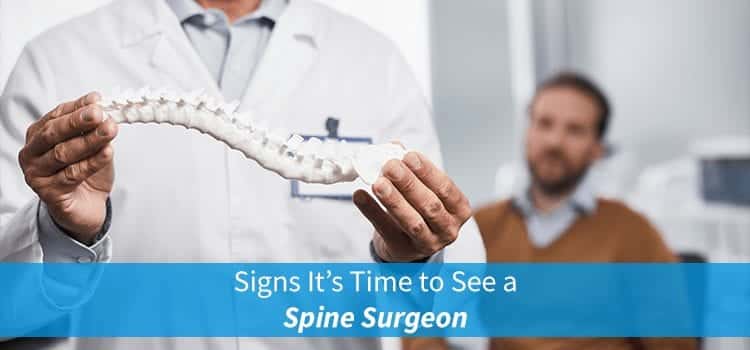Is lower back or neck pain making it difficult to do the things you love? Maybe you’ve tried a couple of conservative treatments but they don’t seem to be helping. You’re probably wondering if it’s time to talk with a spine surgeon.
If so, you’re not alone.
At some point in our lifetimes, most of us will deal with painful conditions that affect the neck or lower back. For some, these issues eventually go away with nothing but time or conservative treatments. However, others will experience symptoms that make their lives miserable. Conservative treatments and therapies just don’t seem to help. They may feel that spine surgery is their only recourse.
But wait, there’s something you need to know…
In many cases, you may not need spine surgery to manage pain and other symptoms. Of course, there are many situations in which an orthopedic doctor may be beneficial (or even needed) to address your pain. But, more on this later…
For now, let’s take a closer look at the spine and common problems that affect it.
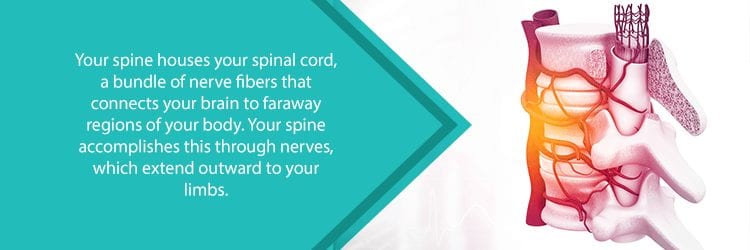
Understanding the Spine
The spine is a series of 33 bones (vertebrae) that start at the base of the skull and end at the tailbone. These bones house the spinal cord—a bundle of nerve fibers that connects the brain to faraway regions of the body. How does the spine accomplish this? Through the use of nerve roots that exit through holes in vertebrae to extend outward to most parts of your body.
Obviously, a basic function of the spine is to protect the spinal cord. In fact, the arch-shaped bones in the middle of your vertebrae collectively form your protective spinal canal.
The spine also has other responsibilities, however. For instance, your back provides balance and structural support to your entire body. This is achieved, in part, with the drum-shaped vertebral bodies at the front of each spinal bone.
The spine also allows for movement, enabling you to bend, twist, and stand upright. At the back of each vertebra are star-shaped processes that attach to muscles in the back. In addition, facet joints connect the bones of your spine together.
Regions of the Spine
The spine is divided up into several key regions. Some of these areas are more prone to injuries than others.
- Cervical spine: Includes seven vertebrae that start at the base of the skull and end at the upper back. This region makes up the neck portion of the spine—one of the two main areas usually responsible for generating spine-related pain.
- Thoracic spine: Consisting of twelve vertebrae below the cervical spine and above the lower back. The thoracic spine has more limited mobility than other regions of the spine because it is connected to the ribs and sternum. However, this also makes it less likely to suffer injury.
- Lumbar spine: The five vertebrae in your lower back. This section of the spine handles most of the body’s weight and allows for the most motion. As such, the lumbar spine is another area often associated with painful conditions.
- Sacral spine: Five bony segments fused together just below the lumbar spine. These bones make up a triangular-shaped bone mass in the pelvis. In addition, the four small bones below the sacral spine make up the tailbone (coccyx), which is often considered its own region. When the connection between the lumbar spine and sacral spine degenerates, it can lead to back problems.
However, the spine is more than just a bunch of bones stacked upon each other. This complex structure requires the aid of muscles and other soft tissues to function properly.
So, what other components up the spine?
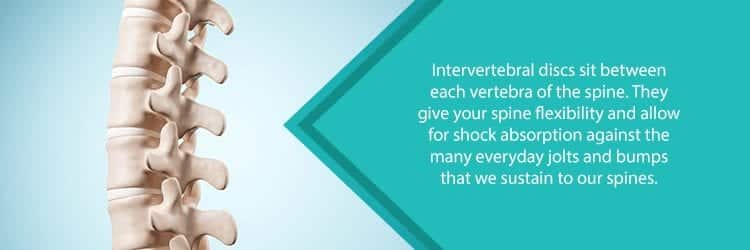
Intervertebral Discs
The drum-shaped vertebral bodies (mentioned above) are cushioned by rubbery discs that resemble a tire. These discs are the spine’s shock-absorbing system. The discs’ outer rings are made up of tough collagen fibers that connect to the vertebrae. Inside the annulus fibrosus is the nucleus pulposus. This inner layer also contains a hydrated gel that helps to resist spinal compression.
Muscles
Two main muscle groups affect the spine. Extensor muscles give us the ability to stand up and lift objects. Located at the front of the spine, our flexor muscles assist with bending forward and controlling the lower back’s arch.
Ligaments
Ligaments are strong fibrous bands that run throughout the spinal column. They stabilize the spine, hold the vertebrae together, and protect the discs. In addition, ligaments also prevent excessive movement of the spine.
When any of these spinal structures are affected by injury, disease, or strain, you can experience pain as well as other symptoms.
Common Spine Conditions
Neck and back pain can originate from a variety of causes. In many cases, back pain is an acute strain to the muscles or tendons of the spine due to overuse or injury. When these soft tissues are injured, they can usually heal with rest and conservative treatments alone.
Of course, sometimes the cause of your pain may be more serious. Here are some common spine conditions that may require the intervention of a spine surgeon:
- Degenerative disc disease: As we age, our discs lose their ability to stay hydrated and become brittle. The stress of our everyday movements can hasten the degradation of these discs. As the discs slowly lose their shape, the spine may become resultantly unstable and compresses nearby nerves.
- Herniated discs: Trauma or repetitive stress to the discs may cause the soft inner layer of the disc to break through the outer layer. This can put pressure on the nerves or spinal cord.
- Osteoporosis: A weakening of the bones that can lead to spinal compression fractures.
- Scoliosis: An abnormal sideways curvature of the spine. For adults, this can result from arthritis, spinal injury, or other disorders. For children, this condition usually develops during adolescent growth spurts.
- Spondylolisthesis: When one vertebra slips out of place due to a defect or fracture in the back of the spine.
- Spinal stenosis: A narrowing of the spinal canal usually due to structural changes in the discs. This can affect the spinal cord and nerve roots, leading to leg and back pain.
While some of these conditions may seem pretty serious, many can initially be treated with more conservative treatments.
If you don’t respond to these treatments or if your symptoms continue to worsen, seeing a spine surgeon is your best bet.
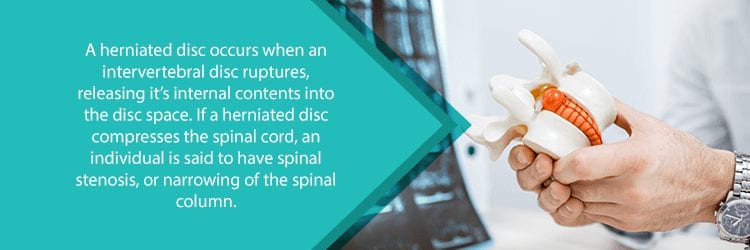
When Should You See A Spine Surgeon?
If you suffer from neck or back pain, the first thing you’ll want to do is consult with your primary physician. Your doctor will perform a physical exam and may request diagnostic imaging like X-rays or MRIs to obtain a better look at the area.
From there, conservative treatments are usually ordered to aid in pain relief and symptom management.
So what conservative treatments are usually recommended for neck and back pain? Of course, this will depend on your individual diagnosis. However, some common conservative treatments include:
- Resting the area
- Limiting physical activity that tends to cause painful flare-ups
- Modifying activities that aggravate your pain
- Heat and/or cold therapy
- Over-the-counter medications such as nonsteroidal anti-inflammatory medications (NSAIDs) like ibuprofen
- Physical therapy
- Chiropractic care
- Exercises to increase the strength and flexibility of an affected area
If your doctor’s suggested conservative treatments don’t seem to help, it may be time to see a spine surgeon.
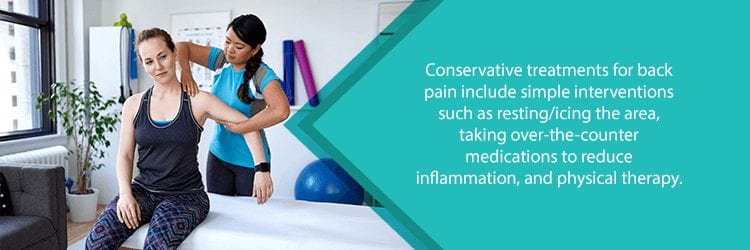
A spine surgeon can help if you suffer from:
- Weakness or numbness in your arms or legs
- Trouble walking
- Difficulty using your hands
- Symptoms of a herniated disc that aren’t getting better
- Broken or dislocated bones in the back
- Spinal stenosis that causes weakness in your extremities
- Loss of bladder or bowel control due to nerve issues in your back
- A tumor on the spinal cord
- Bone spurs—usually caused by arthritis—that apply pressure on your nerve roots or spinal cord.
- Not feeling better after months of conservative treatments
Neurosurgeon vs Orthopedic Surgeon: Which Should You Choose?
In the past, neurosurgeons have performed many of the spine surgeries that you’ve read about. Over the past couple of decades, however, spine surgery has evolved dramatically. Technology improved. Research has given new light to old conditions. And, surgeries have become less invasive.
In addition, orthopedic surgeons who specialize in spine surgery have become equally qualified to perform many surgeries.
Let’s take a closer look at each discipline.
Neurosurgeons
Neurosurgeons complete up to six years of residency focused on treating neurological conditions. They may be Medical Doctors (MDs) or Doctors of Osteopathic Medicine (DO). In addition, neurosurgeons adopt different specialties. Some exclusively perform brain surgery., while others focus wholly on spine surgery. In fact, some may even split their practice between each discipline.
Any neurosurgeon, however, has earned specialized training in diagnosing and treating disorders of the:
- Brain
- Spine and spinal cord
- Nerves
- Blood vessels in the brain and spine
As such, neurosurgeons may be more qualified to perform surgeries inside the spinal cord, such as the excision of thecal sac tumors.
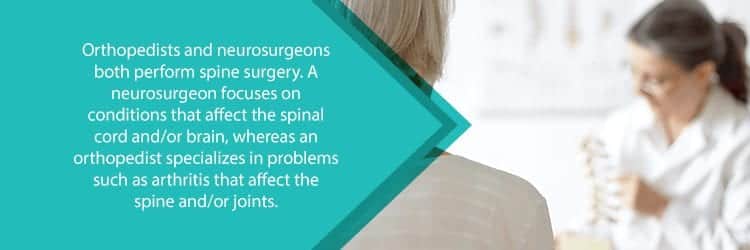
Orthopedic Surgeons
Like neurosurgeons, an orthopedic surgeon can be an MD or a DO. Likewise, each orthopedic surgeon must complete a five-year surgical residency that focuses on treating musculoskeletal conditions. This includes the diagnosis and treatment of bone and joint disorders like:
- Arthritis
- Sports injuries
- Trauma or accidents
- Spinal disorders
- Bone tumors
- Defective joints (hips, shoulders, knees)
Orthopedic surgeons may focus their practice on spine surgery, other joint conditions, or a combination of the two. Specifically, they may be better qualified to address conditions like spinal deformities or scoliosis.
So which should you choose?
For most types of spine surgery, it’s more important to find an individual doctor who specializes in treating your specific condition.
When you consult with an orthopedic surgeon or neurosurgeon, make sure you ask the following questions:
- What surgeries do you specialize in?
- How often do you perform these surgeries?
- How much of your practice is dedicated to treating [your condition]?
- What are the possible risks and complications associated with this surgery?
- How long is a typical recovery?
- What types of treatments or therapy do I need after spine surgery?
- What are the outcomes for similar spine surgeries that you’ve performed?
Of course, it may seem a little awkward to ask these questions to a doctor who has years of experience. Remember, however, that this is your body. You want to make sure you find the best spine surgeon who can help you enjoy your life to the fullest.
Finding the Best Spine Surgeon in New Jersey
Let’s face it: There are a ton of spine surgeons out there. It can be very difficult to choose. Finding a spine surgeon with a dedicated treatment team who specializes in both conservative and surgical approaches to treating your pain is the best option.
NJ Spine & Orthopedic consists of a devoted team of doctors and other medical professionals who have combined decades of experience treating spinal disorders, sports injuries, and other painful conditions.
When you schedule an appointment with NJ Spine & Orthopedic, you immediately receive a team of professionals who are ready to empower you with the best decisions to get your life back. From conservative treatments, minimally invasive procedures, and even complex spine surgery, you can trust that our doctors will care for you with compassion during this difficult time.
Need a diagnosis or second opinion? Why not call us at (855) 586-2615. We’ll take a look at any recent diagnostic imaging that you’ve undergone and help you to determine your next steps in treatment.

